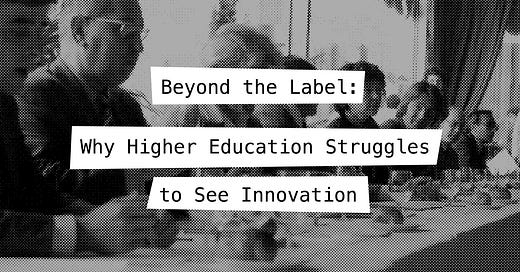Beyond the Label: Why Higher Education Struggles to See Innovation
Focusing on brand over behavior prevents us from seeing the possibilities of innovation right in front of us.
Recently, when I started comparing the strategies of an elite school and a successful for-profit university, an administrator at the elite institution cut me off sternly, insisting the schools were not comparable: “We are not them.”
Similarly, when I first pitched Capitalizing on College to an elite academic publisher, the editor told me they weren’t interested because “books about tuition-driven universities don’t sell.”
In both instances, these leaders exemplify one of the biggest obstacles to recognizing novel strategies in higher education: focusing on brand instead of behavior blinds us to innovation.
Elites set the curve
As discussed in a previous issue, today’s headlines are oversaturated with coverage of elite colleges and universities. The New York Times covers how ongoing political feuds with the current federal administration affect the Ivy League. The Boston Globe frames higher education news primarily through the lens of Harvard and other historic New England schools. The Washington Post highlights the latest developments at Columbia and other top research universities. This skewed emphasis gives the impression that an institution must be one of the elites in order to gain attention and respect.
The Ivies, “little Ivies,” and “aspiring Ivies” not only capture the public’s understanding of higher education, but are also viewed as maintaining the “best practices” that other institutions seek to emulate. Many colleges and universities aspire to climb the rankings into this upper echelon and make strategic decisions accordingly. In this reciprocating relationship, widespread imitation (known in the management world as isomorphism) incentivizes elites to stay the course. Rather than inspiring innovation, the pursuit of brand prestige in our higher education system reinforces institutional inertia. In short, elites set the curve for the rest of the class.
Look at the action, not the label
The 2008 movie Bottle Shock tells the story of the “Judgment of Paris,” a 1976 blind taste test in which a no-name California wine outperformed the elite French wines it was up against. This sent shockwaves through the wine world, which had long been accustomed to the dominance of elite French vintages. It also helped establish California wines on the map, now undeniably considered among the best in the world.
Just as with wine, quality in higher education is not exclusive to the Château Margaux and Dom Pérignon equivalents of colleges and universities. In reality, innovation is often found in unexpected places (like the childhood garage of two friends named Steve and Steve). For example, most elites are not monitoring innovative educational practices happening at institutions such as National University, which remains on the cutting edge of online and nontraditional learning and supporting student-athletes. Similarly, few Ivy League schools are paying attention to Western Governors University, a leading innovator in apprenticeships for adult learners and open source learning platforms. Since these institutions lack the brand recognition enjoyed by elite counterparts, they are often overlooked both within and outside the higher education sphere. However, as nearly every trendline indicates, the practices that they pioneer will likely dominate higher education in the not-so-distant future.
When organizational and management scholars seek a new strategy or innovation, they don’t turn to established brands like Nike or Adidas. Rather, they examine emergent or novel actions being taken anywhere in the sector – like when a company creates a shoe using “spray on” technology or markets “wine in a box.” Whether in footwear, wine, or higher education, achieving elite brand status often comes with the pressure to preserve the practices that led to success, while the center of innovation shifts to the institutions and organizations focused on surviving and thriving. To put it another way, as I say in Capitalizing on College, tuition-driven institutions innovate, elites legitimate.
The benefit of looking across sectors
The more higher education can learn to look across sectors, the more innovation-blocking silos we will be able to eliminate. While developing this practice won't happen overnight, here are some ways to start broadening our perspectives:
Look across organizational types: As I covered in a previous issue, and as the elite academic editor in the opening vignette made plain, higher education has a difficult time recognizing the value that exists across institutions. While the diversity among tuition-driven schools might seem to emphasize differences, a thread of mission-focused innovation––what I call value entrepreneurism––ties them together. For example, when we focus on action rather than brand, we realize that religious schools share more in common with HBCUs than with Ivies. HSIs and PBIs have more commonalities with women’s colleges than with elite universities. By prioritizing shared values, colleges and universities can learn from and support one another. After all, innovation usually originates at the margins, not at the top.
Look across industries: While many school administrators are understandably resistant to this framing, higher education is a business. Especially in our American system driven by competition, schools ultimately live or die by their ability to attract students – that is, to “sell” (enroll) their “product” (degrees and certificates). Schools that embrace this reality and analyze actions over branding quickly realize that many basic business principles are essential to running a successful mission-focused institution.
Similarly, higher education should look to traditionally innovation-friendly industries for inspiration. While a healthy dose of caution is warranted, the tech industry and educational technology has the potential to transform how colleges and universities achieve their missions in countless ways. For instance, many early adopters of these technologies that I describe in Capitalizing on College developed innovative methods for delivering educational opportunities to new populations of students previously excluded from the elite residential model.Look across ideologies: Last week I was in Washington, D.C. to attend a meeting with representatives across the spectrum of ideologies in American politics. While the situation is often portrayed as starkly black and white, these D.C. insiders insisted that within both the Democrat and Republican parties, there are committed centrists as well as nihilists who want to burn it all down. Applying this final principle to higher education, they advised that, moving forward in this climate, university presidents should start by identifying and working with centrists of both parties to initiate the conversation.
Whether in the halls of Congress or the halls of the Ivory Tower, let’s not assume that the solution only resides from within our own camp. Both innovation and allies often come from unexpected places.
Extra Edge
Issue Soundtrack: Kick Drums & Red Wine by The Midnight
Can you cover for me?: If you already have a copy of Capitalizing on College, could you do me a HUGE favor? Please take a pic of the cover of the book and post it to social media this week with the tag #CapitalizingOnCollege! This helps tremendously in getting the word out.
Chronicle Interview: I was recently interviewed by Scott Carlson, Senior Writer of The Chronicle about my new book. We candidly discussed what surprised me, the impact of competition, societal revolt toward higher education, and strategies at places like ASU, SNHU, BYU, Paul Quinn, and more – check it out here.
Writing Playlists: Need some new energy for your own writing project or workday tasks? I’ve made the up-tempo music playlists that I use for writing available for others to use too! Each of the six lists has a different theme: Eclectic Hope, Ambient Sunshine, Energetic Focus, Belief with Bass, Rhythmic Confidence, and Inspired by Anime.





